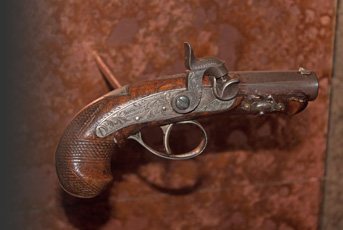A Guide to Collecting Derringers
-
412
 Comments
Comments
- Last updated: 15/12/2016

Henry Deringer was an accomplished gun maker who produced a variety of pistols and rifles in the middle part of the nineteenth century, but his name will forever be associated with the small, single-shot, large calibre pistols that bore his name.
Many are the accounts of homicides where witnesses have indicated that the assailant used a “Deringer pistol” and without doubt the most famous of these was the assassination of Abraham Lincoln by John Wilkes Booth in 1865. Now the word ‘derringer’ had become a common noun in the language, used to describe any small pocket pistol. The use of the double ‘r’ and lower case ‘d’ refers to any of these small pocket pistols, while the single ‘r’ and upper case ‘D’ describes the actual products of Henry Deringer.
From Percussion To The Coming Of The Cartridge
During the percussion era, the design of these small pistols was determined by the ignition system, which meant they were generally single shot weapons, although one firm, W.W.Marston, did produce a three shot .31 calibre model in the late 1850’s. Production of this pistol was extremely limited, perhaps as low as 20 examples, as the company very soon adapted the design to take rimfire cartridges. With the advent of the metallic cartridge, manufacturers could double or even quadruple the firepower of these easily concealed firearms, and many did exactly that. The Rollin White patent, held by Smith & Wesson, prohibited other manufacturers from producing breech loading revolvers until 1869, but this did not stop them from making small pistols in which the cartridge was loaded directly into the barrel. Hence cartridge derringers were around almost immediately that the rimfire ammunition was commonly available. They continued to be made for rimfire long after the centrefire cartridges were perfected in the 1870’s. Presumably this was because there was an abundance of rimfire ammunition and these small guns were cheap to produce.
Strangely enough, Smith and Wesson, who brought out the first breech loading revolver – a .22 rimfire – have never produced a pistol that could be described as a derringer. Most of the other big names in the firearms business however, took advantage of the popularity of these ‘hideaway’ guns.
Bridging the design gap between percussion and metallic cartridge derringers (although it did not appear until c.1866) was the Williamson single shot model. This was a .41 calibre weapon with a chequered walnut stock, into which was fitted a brass frame and a 2½” blued steel barrel. The pistol had a central hammer and a brass trigger guard, and the overall silhouette was not unlike Henry Deringer’s original. The barrel slides forward for loading but its unusual feature is that it also accepts a supplementary percussion chamber. This was loaded with powder and ball, capped and placed into the breech instead of the .41 rimfire cartridge, the hammer having a separate nose for each system. Although the patent for this pistol was granted to David Williamson, there was no Williamson Company as such, so these pistols were actually made by Moore’s Patent Fire Arms Co. or the National Firearms Company.
The aforementioned Moore’s P.F.A. produced what was arguably the first successful cartridge derringer, patented in February 1861, although production started before the patent was granted. This is an all metal .41 rimfire pistol with a 2½” barrel that pivoted down and to the left for loading – the patent drawing showed a centre fire model and about 10 are known to exist. The frame is of silver plated brass (some iron are known but are scarce) and the steel barrel either plated or blued. Scroll engraving is standard on the frame and breech end of the barrel. Moore’s was taken over in 1865 by the National Firearms Co. who continued production of this derringer and between the two companies about 10,000 were made. National produced a modified version of the Moore, differing only in the grips (the latter having bird’s head walnut grips), the two being marketed simultaneously as the No. 1 and No. 2 National derringers. About 5,000 of the second type were made up to 1870.
Remington’s Derringers
Probably the most easily recognised of all derringers is the Remington .41 calibre over and under. Produced from about 1866 right up until 1935, there are many of these pistols available today to the collector. It is estimated that around 150,000 were produced in .41 short rimfire calibre. The normal barrel length was three inches and standard finish was blue or nickel-plated or a combination of the two. Optional finishes were silver or gold plated and engraving with a choice of ivory or pearl stocks. An 1888 Remington catalogue lists the standard pistol at $8.00, with ivory stocks an extra $4.00 and a further $4.00 for engraving. Ammunition was priced at $1.50 per hundred! Like the Henry Deringer pistols, this model was widely copied and even today modern replicas are available for current centrefire calibres.
Whilst the over and under was doubtless Remington’s most famous and prolific derringer, it was by no means the company’s only foray into this very lucrative market. From about 1860 onwards Remington produced a number of small pistols in calibres from .17 upwards, and with anything from one to six barrels. One of the more innovative was the Remington Elliot “Zig-Zag” Pocket Revolver. This was a six-barrelled .22 rimfire weapon with a ring trigger which automatically turned the barrel cluster with each pull. Produced for only about a year, this model was followed by a five shot .22 and a four shot .32, both with fixed barrel clusters and rotating firing pins.
